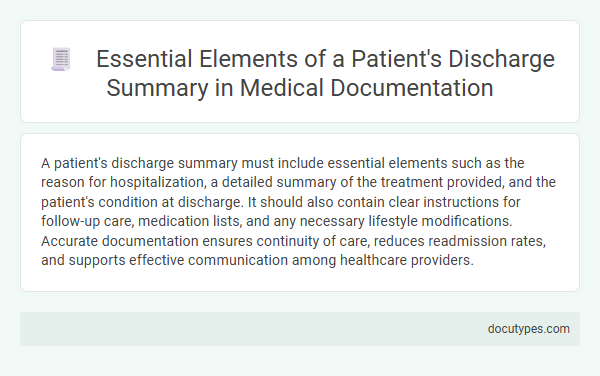A patient's discharge summary must include essential elements such as the reason for hospitalization, a detailed summary of the treatment provided, and the patient's condition at discharge. It should also contain clear instructions for follow-up care, medication lists, and any necessary lifestyle modifications. Accurate documentation ensures continuity of care, reduces readmission rates, and supports effective communication among healthcare providers.
Patient Identification and Demographics
What are the key components of patient identification and demographics in a discharge summary? Accurate patient identification ensures the correct medical records are referenced, preventing errors in ongoing care. Your discharge summary must include essential demographic details such as full name, date of birth, and contact information for precise patient tracking and follow-up.
Admission and Discharge Dates
A patient's discharge summary must clearly state the admission and discharge dates to provide a precise timeline of care. These dates are vital for tracking the duration of hospitalization and coordinating follow-up treatments. Accurate documentation of your admission and discharge ensures continuity of care and supports medical record accuracy.
Primary Diagnosis and Comorbidities
A patient's discharge summary must clearly identify the primary diagnosis to ensure accurate treatment follow-up and continuity of care. Comorbidities should be thoroughly documented to provide a complete clinical picture and guide future medical management.
- Primary Diagnosis - Represents the main medical condition necessitating hospitalization or treatment during the admission.
- Comorbidities - Includes any additional diseases or disorders present that may affect the patient's prognosis and treatment plan.
- Clinical Impact - Accurate listing of the primary diagnosis and comorbidities improves communication among healthcare providers and supports effective patient safety strategies.
Summary of Hospital Course
The Summary of Hospital Course is a critical component of a patient's discharge summary, detailing the progression of your condition during the hospital stay. It includes key diagnostic findings, treatments administered, and any complications encountered.
This section provides healthcare providers with a clear timeline of interventions and patient responses, ensuring continuity of care after discharge. Accurate documentation in this summary supports effective follow-up and patient safety.
Procedures and Interventions Performed
The discharge summary must clearly document all procedures and interventions performed during the patient's hospital stay. Accurate recording ensures continuity of care and informs future treatment decisions.
- Procedure Name and Date - Specify the exact procedure performed along with the date to establish a clear timeline of care.
- Method and Technique - Describe the surgical or therapeutic methods used to provide clarity on the intervention details.
- Complications and Outcomes - Note any complications encountered and the results of the procedures to guide ongoing patient management.
Complete and precise details about procedures and interventions support safe transitions from hospital to home or another care setting.
Medications at Discharge
A patient's discharge summary is a critical document that outlines the essential elements needed for safe and effective post-hospital care. One of the most important components is the section detailing medications at discharge.
This section lists all prescribed medications, including dosages, frequency, and duration. It highlights any changes made during the hospital stay and notes medications that should be discontinued. Clear medication instructions help prevent errors and ensure you understand your treatment plan after leaving the hospital.
Follow-up Appointments and Referrals
Follow-up appointments are critical components of a patient's discharge summary, ensuring continuity of care and timely monitoring of recovery progress. Detailed information about the date, time, and healthcare provider for these appointments must be clearly documented to facilitate patient adherence. Referrals to specialists or other healthcare services should include specific reasons for the referral, contact details, and any necessary patient instructions to guarantee coordinated and efficient care transitions.
Discharge Instructions and Patient Education
| Essential Element | Description | Importance |
|---|---|---|
| Discharge Instructions | Clear, detailed guidelines provided to the patient regarding medication schedules, wound care, activity restrictions, diet, and follow-up appointments. | Ensures patient safety, promotes healing, and minimizes risk of readmission by providing actionable steps post-hospitalization. |
| Patient Education | Information tailored to the patient's condition, including signs of complications, management of chronic diseases, and lifestyle modifications. | Empowers patients with knowledge to manage their health effectively and recognize when to seek medical attention. |
Pending Test Results and Notifications
Pending test results are critical components in a patient's discharge summary, ensuring continuity of care after hospital release. These results alert outpatient providers to follow up on necessary diagnostics that may impact treatment decisions.
Clear notifications regarding pending tests prevent gaps in communication between healthcare teams and patients. Timely updates on test outcomes support effective monitoring and reduce risks of complications or readmissions.
What Are the Essential Elements in a Patient’s Discharge Summary? Infographic

